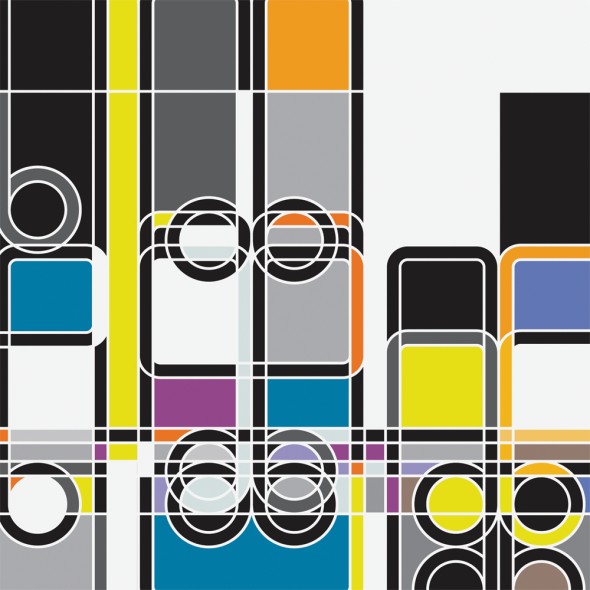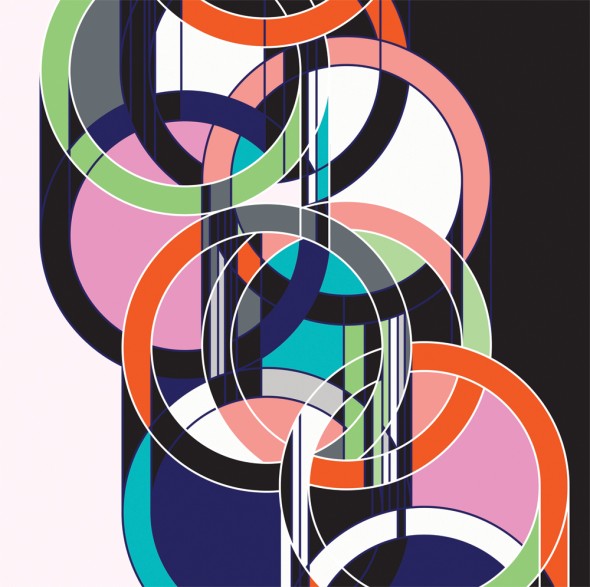
Owl (Paperclip), 2009
Structures of Control: Chasing cultural Connections with Sarah Morris
minimum number (in lbs) of paper clips us manufacturers developed last year: 20 million, number of sheets of paper used while researching, editing, writing, and producing this feature: 53, number of paper clips needed to hold said pages together: 1.
“I cannot live in this world without a paper clip.”— Francisco Roselada, Deputy Clerk Small Claims Division Superior Court of California, County of San Francisco
Sarah Morris has thought about paper clips quite a bit in the past few weeks. In fact, there is a good chance that they surround her as she speaks this very second over the phone from her Parallax studio in Chelsea. The acclaimed contemporary artist, director, and designer has spent the better part of the month focusing her attention on the iconic oval-within-oval shape for an upcoming exhibit at the end of October in New York. The affair will showcase a new series of paintings that focus on both knots and paper clips, and marks the first time her new film, shot during the 2008 Beijing Olympics, will be seen in the states. For those unfamiliar with her work, this pairing might seem esoteric at best, yet Morris has always had an uncanny knack for finding and exploring such connections. And while her art is breathtaking in scope and aesthetically intelligent, one could argue that her true gift, as an artist and critical thinker, is an ability to trace familiar patterns and compositions to a bigger picture.
Regarding knots and paper clips, Morris says, “I think I chose these two forms for a number of reasons. They are both fascinating structures to me, and I love the history of it—the bureaucracy, the invention of paper, and the idea of storage and archival cataloging of paper work. We all know it is endless, even if it is on a virtual level.” She adds, “The paper clip goes back to that initial development of organization and archiving. Basically, this is about bureaucratic structures of control and also the ignoring of these bureaucratic structures. In no way am I saying that these forms, while they are still quite dominant, can’t also be subverted. It’s a capitalist form and an important one.” She pauses for a moment and deadpans, “It’s up there with the staple.”
It should be noted that, while she was born in the U.K in 1967, her accent is most noticeable when she cracks a joke. One can only imagine that English laugh distinguishing Morris among her peers while finishing the Whitney Museum’s Independent Study Program in the ’90s, and while working as an assistant to Jeff Koons. It was probably evident later as well, in the company of Hollywood royalty like Warren Beatty and Robert Towne when she directed the films Los Angles and Robert Towne; and in the West Wing during the Clinton Administration (for the film Capital). It is also refreshing to know that she has kept this sense of humor given the intensity of some of her subjects.
Her paintings, which often impose colorful grids made with standard household gloss, draw comparisons from the field of architecture and retain an urban, and even corporate tone. Morris chooses colors for the work from a number of sources. For example, Downtown Beijing buildings, children’s sandals, cigarette packs, and other industry products inspired her Rings series. When asked what informed the Paperclip paintings, she says, “The manila envelope is certainly one of them, but it also might come from films as well. I am looking at early ’80s films, and things like the inside of Dallas International Airport, and Peter Saville’s work.” She adds, “In terms of the references and color, I find inspiration everywhere. There is no certain system, besides an open system for me.”

2002 (Rings), 2007
Initially, one might be drawn to the symmetrical abstractions and use of framing that invites viewers to trace their eyes along the patterns on the canvas. However, a nod towards social psychology begins to take shape the more times one interacts with the work, and how the viewer relates to the particular setting where the work is shown. It is a fitting connection, as Morris is an artist who has both an intrapersonal and interpersonal intelligence in spades. She is self-reflective, but not self-absorbed. She can spot a cultural shift a mile away, but believes that it is a myth that the public “demands or dictates taste.” Following her train of thought as it skips through topics over the course of a 45-minute interview is a bit like tending to a southern California wildfire or trying to watch the wings of a hummingbird—it moves fast and with precision.
When asked if there is a connection between social psychology and her paintings, she quickly mentions how the success and failures of a historical moment can shape our perception, how films like The Conversation and Parallax were precursors to Watergate, the level of doubt regarding the current financial crisis, and then back to how, to her, these things are malleable as an artist. She ends by saying, “I definitely think that art and cultural production can change people’s perceptions of the reality they live under. That could include a social space, design, politics or looking at mainstream forms differently. If that was not the objective, I don’t know why I would be making art.”
Like her paintings, Morris’ films also address the bureaucratic entanglements, failed historical moments, and strips them to visual interpretations that are engaging, intimate, and claustrophobic at times. While these works might not be as physically intense as, say, Werner Herzog hauling a 320-ton steamship over a mountain in his Fitzcarraldo film, it could be argued that Herzog also never had to deal with a modern day bureaucratic nightmare of getting the rights and permission to film in China last year.
Still wary from the experience, Morris says of the process of making her new film Beijing, “It wasn’t treacherous, but it was a bureaucracy on just another proportion. You have an international Olympic committee and each country has its own organization, so we had this crazy chart in the studio, mapping out how we were going to infiltrate this structure. On top of that, you have China,” she says. “There were so many people that said ‘yes,’ when they meant ‘no.’ There were people who said ‘no’ and then turned out saying ‘yes.’ It was so infuriating that several times I had to start considering the idea of failure because the bureaucracies that were subjects in my work might not even allow me to work.”
In the end, Morris got her film, and by all accounts, Beijing was a success (even if it was successful showing the failure of the Summer ‘08 Games). It is interesting to note that the idea of success or failure, regardless of planning, is very much a part of what she still considers mysterious when creating art. “As an artist, you can think, plan, design, and talk about it as much as you want, but there is this final moment where you have to ask yourself, ‘Is this going to work in the space?’ You cannot even hope to try and calculate that moment. That final moment is quite mysterious and it gets back to the paper clip, it is sort of endless.”
– Patrick Knowles

